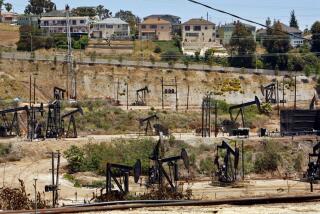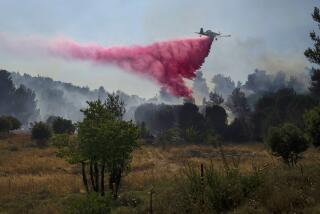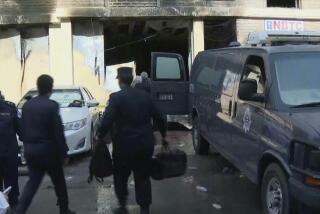At Last, a Silver Lining in Black Clouds Over Kuwait : Oil fires: Multinational team nears victory in the battle with wells set aflame by Iraq during the Gulf War.
BURGAN OIL FIELD, Kuwait — “It’s gusted,” drawled Dale Jones as a white-hot geyser of flaming oil and gas suddenly disappeared, snuffed out and transformed into a black fountain of crude oil silhouetted against the grim gray smoke that has blanketed Kuwait since the end of the Persian Gulf War.
In the past month, an army of firefighters has been pouring it on in the battle to drown the oil-well fires torched off by Iraqi saboteurs in February. Kuwaiti officials are now predicting that the last fire may be extinguished by mid-November, 15 months earlier than the estimates made just after the war. Credit is given to the government decision to flood the oil fields with firefighting crews, a multinational force that greatly expanded the initial American-led efforts. About 80% of the world’s oil firefighters are now working here.
The sky over Kuwait city, dark with a midday gloom through the spring and summer, has been streaked with a welcomed blue the past two weeks. A full accounting of the pollution damage is still under study, but the well fires--the engine of the disaster--are disappearing daily.
At the beginning of this week, the number of wells still burning was 20, a fraction of the 640 blasted into flames by Iraqi President Saddam Hussein’s doomed forces in Kuwait eight months ago. Another 92 were knocked out by other war damage. Only 200 of Kuwait’s oil wells escaped the conflict unscathed.
Here in the Burgan field, 25 miles south of the capital, each firefighting team was taking on the remaining fires one at a time last week. Jones, a medic from Starkville, Miss., attached to a team from the Red Adair Co., said each well presented unique problems. The one he declared “gusted”--oil field lingo for snuffing out a burning well--was a nasty assignment: A high degree of gas was being spewed out along with the crude.
While nearby wells burned with red and orange flame, this one flared a roiling silvery-yellow geyser. The heat was intense, baking an onlooker’s skin at 100 yards’ distance, and Adair’s men, in their distinctive red coveralls, were working within 20 yards of the flames.
“They’re walking the dog,” explained Jones as firefighters trained streams of seawater piped in from the Persian Gulf at the base of the fiery plume, then slowly raised their aim, pushing the flame away from the red-hot wellhead.
“Should have it in a minute,” he predicted, calling it on the button, as the fire, roaring like a passing train, puffed out with one last whoosh , leaving only an oil plume.
“They’ll be taking that one on tomorrow,” Jones said, pointing at a nearby geyser, rolling with red flames from oil spilled around the base. The Adair technique is to extend a barrel of explosives at the end of a crane over the wellhead.
The blast is designed to knock over the “Christmas tree,” the valve apparatus atop the well. With the tree removed, the flames shoot up directly from the well pipe, presenting an easier target for the men with the hoses.
With the tree still in place, the fires spew wildly at the base of the wellhead, making it difficult to move in equipment and hoses. The Americans are still talking about a tough one they nicknamed “the Texas Longhorn” when they tackled it last spring. The flames were rising in two directions from the wellhead.
“The Iraqis knew what they were doing,” said Jean-Paul Saulnier, a Canadian from Edmonton working with the Houston-based Wellcaps Co. “They put their charges right where they would do the most damage.”
Among the 28 teams now working in Kuwait--American, French, Kuwaiti, British, Chinese and others--the recent arrivals from Hungary and Romania have provided the most unusual technique. They brought in devices that use old jet engines to snuff out a well. Mounted on a tank body (the Hungarians) or the back of a flatbed truck (the Romanians), the jet is brought up after normal firefighting techniques--bulldozing burning crude from the area around the wellhead and hosing the target to cool it off--set up a well for the kill. Water is sucked into eight nozzles attached to the engine and blown with increasing force on the flames as the jet is fired up.
It’s noisy but effective.
“Any way you do it,” said Gene Rose of Oklahoma City, a member of the Wellcaps crew, “the idea is the same. You put water on the fire.”
The capping crews take over then, shutting down the plumes of crude oil that stand as sentinels of firefighting success in the 20-mile-wide Burgan field and others in the north of the sheikdom.
But the cost in money and environmental damage has been awesome. The Burgan field, southwest of the city of Ahmadi, is Kuwait’s largest, with about 400 wells. On approach to Kuwait city on a night flight two weeks ago, the field appeared as an inferno of red flame and black smoke, like a monstrous California wildfire. Six months ago, the scene was far worse, and Burgan’s scars have not begun to heal.
The wells are spotted in the open desert, now an oily landscape in black. Lakes of spilled oil an acre or more in size stand alongside the mine-cleared roads. Toward Kuwait city, the air is relatively clear, but as one drives southwest into the field, the horizon remains blotted by a towering wall of smoke. The desert is covered with a blanket of two inches or more of oil that has fallen from the smoky sky.
Camels, goats, foxes and other small animals that once lived on this land are dead or dying, the scrub brush and other vegetation that fed them covered with oil.
Kuwaiti officials once estimated that the disaster would cost the sheikdom $75 billion, primarily in the loss of exports during the eight-month Iraqi occupation and diminished production until prewar levels were reached. More recently, they have admitted that the estimate was based on rough predictions and that the actual figure will be considerably lower.
The cost of firefighting and other recovery operations should run less than $3 billion, according to Western diplomats. Last week, Oil Minister Hamoud Rogba said that less than 2% of Kuwait’s estimated 100 billion barrels of oil reserves have been lost, compared to an earlier prediction of 3%.
The costs of environmental damage are still being measured. Kuwaiti officials have been quoted in local newspapers as saying that cleanup costs alone will run more than $1 billion. According to Western diplomats, environmental studies are focused on air pollution, seawater pollution (Kuwait’s drinking water comes from desalination plants on the Gulf) and damage to the desert itself.
Meanwhile, the government-owned Kuwait Oil Co. is back in business, producing 290,000 barrels a day from operating wells. Oil Minister Rogba predicted that production will reach 400,000 barrels a day by the end of the year.
But the disaster will not be forgotten by the Kuwaitis and the foreign crews that came here to fight the fires.
“I’ve been in the oil fields for 40 years,” said Luther Young, 65, of Weatherford, Tex., who was called out of retirement by the Red Adair Co. to work at Burgan. “I don’t think anyone has ever seen anything like this. I know I haven’t.”
More to Read
Sign up for Essential California
The most important California stories and recommendations in your inbox every morning.
You may occasionally receive promotional content from the Los Angeles Times.









